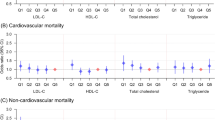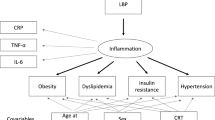Abstract
Objective:
The adipocytokine leptin is an independent cardiovascular risk factor and exerts prothrombotic effects, both in arterial and venous thrombosis. We therefore investigated the relationship between leptin levels and clinical outcome in patients with acute pulmonary embolism (PE).
Design:
We prospectively studied consecutive patients with confirmed acute PE admitted at the University Hospital of Goettingen (Germany) between 2003 and 2009.
Subjects:
The study subjects were a total of 264 patients with PE (median age, 68 years; interquartile range, 53–75; 60% women; body mass index (BMI) 27 kg m−2 (24.1–31.2)). Leptin levels were determined by a commercially available enzyme-linked immunosorbent assay. Patients were followed for an adverse 30-day outcome, that is, death, circulatory collapse with need for catecholamines, intubation or resuscitation, and for long-term survival.
Results:
The median leptin level was 10.1 ng ml−1 (3.7–25.2). Patients (n=49; 18.6%) with a complicated 30-day course had significantly lower leptin levels (5.3 ng ml−1 (1.8–19.7) compared with patients without complications (10.4 ng ml−1 (4.7–25.5), P=0.02). When leptin was analyzed as a continuous variable, there was a significant 36% increase in the relative risk for early complications for every decrease in the natural logarithm of leptin by one s.d. (odds ratio (OR) 1.36 (1.06–1.76), P=0.017), independently of BMI (BMI-adjusted OR, 1.52 (1.13–2.05), P=0.006). In addition, patients within the lowest leptin tertile had a 2.8- and 2.3-fold increased risk for 30-day-complications, compared with those in the middle (P=0.011) and high tertile (P=0.030), and a worse probability of long-term survival (log-rank; P=0.018).
Conclusion:
Low plasma leptin concentration is a predictor for a complicated course and high mortality in patients with acute PE. This association is independent of known factors affecting leptin levels, including gender and obesity.
This is a preview of subscription content, access via your institution
Access options
Subscribe to this journal
Receive 12 print issues and online access
$259.00 per year
only $21.58 per issue
Buy this article
- Purchase on Springer Link
- Instant access to full article PDF
Prices may be subject to local taxes which are calculated during checkout


Similar content being viewed by others
References
Zhang Y, Proenca R, Maffei M, Barone M, Leopold L, Friedman JM . Positional cloning of the mouse obese gene and its human. Nature 1994; 372: 425–432.
Yang R, Barouch LA . Leptin signaling and obesity: cardiovascular consequences. Circ Res 2007; 101: 545–559.
Dellas C, Schafer K, Rohm IK, Lankeit M, Leifheit M, Loskutoff DJ et al. Leptin signalling and leptin-mediated activation of human platelets: Importance of JAK2 and the phospholipases Cgamma2 and A(2). Thromb Haemost 2007; 98: 1063–1071.
Konstantinides S, Schäfer K, Koschnick S, Loskutoff DJ . Leptin-dependent platelet aggregation and arterial thrombosis suggests a mechanism for atherothrombotic disease in obesity. J Clin Invest 2001; 108: 1533–1540.
Konstantinides S, Schäfer K, Neels JG, Dellas C, Loskutoff DJ . Inhibition of endogenous leptin protects mice from arterial and venous thrombosis. Arterioscler Thromb Vasc Biol 2004; 24: 2196–2201.
Bodary PF, Westrick RJ, Wickenheiser KJ, Shen YC, Eitzman DT . Effect of leptin on arterial thrombosis following vascular injury in mice. JAMA 2002; 287: 1706–1709.
Bouloumie A, Marumo T, Lafontan M, Busse R . Leptin induces oxidative stress in human endothelial cells. FASEB J 1999; 13: 1231–1238.
Schäfer K, Halle M, Goeschen C, Dellas C, Pynn M, Loskutoff DJ et al. Leptin promotes vascular remodeling and neointimal growth in mice. Arterioscler Thromb Vasc Biol 2004; 24: 112–117.
Vecchione C, Maffei A, Colella S, Aretini A, Poulet R, Frati G et al. Leptin effect on endothelial nitric oxide is mediated through Akt-endothelial nitric oxide synthase phosphorylation pathway. Diabetes 2002; 51: 168–173.
Smith CC, Mocanu MM, Davidson SM, Wynne AM, Simpkin JC, Yellon DM . Leptin, the obesity-associated hormone, exhibits direct cardioprotective effects. Br J Pharmacol 2006; 149: 5–13.
Schroeter MR, Leifheit M, Sudholt P, Heida NM, Dellas C, Rohm I et al. Leptin enhances the recruitment of endothelial progenitor cells into neointimal lesions after vascular injury by promoting integrin-mediated adhesion. Circ Res 2008; 103: 536–544.
Heida NM, Leifheit-Nestler M, Schroeter MR, Muller JP, Cheng IF, Henkel S et al. Leptin enhances the potency of circulating angiogenic cells via src kinase and integrin (alpha)vbeta5: implications for angiogenesis in human obesity. Arterioscler Thromb Vasc Biol 2010; 30: 200–206.
Wallace AM, McMahon AD, Packard CJ, Kelly A, Shepherd J, Gaw A et al. Plasma leptin and the risk of cardiovascular disease in the West of Scotland Coronary Prevention Study (WOSCOPS). Circulation 2001; 104: 3052–3056.
Wolk R, Berger P, Lennon RJ, Brilakis ES, Johnson BD, Somers VK . Plasma leptin and prognosis in patients with established coronary atherosclerosis. J Am Coll Cardiol 2004; 44: 1819–1824.
Glynn RJ, Danielson E, Fonseca FA, Genest J, Gotto Jr AM, Kastelein JJ et al. A randomized trial of rosuvastatin in the prevention of venous thromboembolism. N Engl J Med 2009; 360: 1851–1861.
Munzberg H, Myers Jr MG . Molecular and anatomical determinants of central leptin resistance. Nat Neurosci 2005; 8: 566–570.
Considine RV, Sinha MK, Heiman ML, Kriauciunas A, Stephens TW, Nyce MR et al. Serum immunoreactive-leptin concentrations in normal-weight and obese humans. N Engl J Med 1996; 334: 292–295.
Kolaczynski JW, Nyce MR, Considine RV, Boden G, Nolan JJ, Henry R et al. Acute and chronic effects of insulin on leptin production in humans: Studies in vivo and in vitro. Diabetes 1996; 45: 699–701.
Haffner SM, Mykkanen L, Rainwater DL, Karhapaa P, Laakso M . Is leptin concentration associated with the insulin resistance syndrome in nondiabetic men? Obes Res 1999; 7: 164–169.
Ageno W, Prandoni P, Romualdi E, Ghirarduzzi A, Dentali F, Pesavento R et al. The metabolic syndrome and the risk of venous thrombosis: a case-control study. J Thromb Haemost 2006; 4: 1914–1918.
Binder L, Pieske B, Olschewski M, Geibel A, Klostermann B, Reiner C et al. N-terminal pro-brain natriuretic peptide or troponin testing followed by echocardiography for risk stratification of acute pulmonary embolism. Circulation 2005; 112: 1573–1579.
Konstantinides S, Geibel A, Olschewski M, Kasper W, Hruska N, Jackle S et al. Importance of cardiac troponins I and T in risk stratification of patients with acute pulmonary embolism. Circulation 2002; 106: 1263–1268.
National Kidney Foundation. K/DOQI Clinical Practice Guidelines for Chronic Kidney Disease: Evaluation, Classification and Stratification. Am J Kidney Dis 2002; 39: S1–S000.
Soderberg S, Stegmayr B, Ahlbeck-Glader C, Slunga-Birgander L, Ahren B, Olsson T . High leptin levels are associated with stroke. Cerebrovasc Dis 2003; 15: 63–69.
Soderberg S, Stegmayr B, Stenlund H, Sjostrom LG, Agren A, Johansson L et al. Leptin, but not adiponectin, predicts stroke in males. J Intern Med 2004; 256: 128–136.
Ku IA, Farzaneh-Far R, Vittinghoff E, Zhang MH, Na B, Whooley MA . Association of low leptin with cardiovascular events and mortality in patients with stable coronary artery disease: the Heart and Soul Study. Atherosclerosis 2011; 217: 503–508.
Scholze A, Rattensperger D, Zidek W, Tepel M . Low serum leptin predicts mortality in patients with chronic kidney disease stage 5. Obesity (Silver Spring) 2007; 15: 1617–1622.
Piemonti L, Calori G, Mercalli A, Lattuada G, Monti P, Garancini MP et al. Fasting plasma leptin, tumor necrosis factor-alpha receptor 2, and monocyte chemoattracting protein 1 concentration in a population of glucose-tolerant and glucose-intolerant women: impact on cardiovascular mortality. Diabetes Care 2003; 26: 2883–2889.
Lavie CJ, Milani RV, Ventura HO . Obesity and cardiovascular disease: risk factor, paradox, and impact of weight loss. J Am Coll Cardiol 2009; 53: 1925–1932.
Uretsky S, Messerli FH, Bangalore S, Champion A, Cooper-DeHoff RM, Zhou Q et al. Obesity paradox in patients with hypertension and coronary artery disease. Am J Med 2007; 120: 863–870.
Romero-Corral A, Montori VM, Somers VK, Korinek J, Thomas RJ, Allisaon GA et al. Association of bodyweight with total mortality and with cardiovascular events in coronary artery disease: a systematic review of cohort studies. Lancet 2006; 368: 666–678.
Kenchaiah S, Evans JC, Levy D, Wilson PWF, Benjamin EJ, Larson MG et al. Obesity and the risk of heart failure. N Engl J Med 2002; 347: 305–313.
Oreopoulos A, Padwal R, Kalantar-Zadeh K, Fonarow GC, Norris CM, McAlister FA . Body mass index and mortality in heart failure: A meta-analysis. Am Heart J 2008; 156: 13–22.
Martin SS, Qasim A, Reilly MP . Leptin resistance: a possible interface of inflammation and metabolism in obesity-related cardiovascular disease. J Am Coll Cardiol 2008; 52: 1201–1210.
Faggioni R, Fantuzzi G, Gabay C, Moser A, Dinarello CA, Feingold KR et al. Leptin deficiency enhances sensitivity to endotoxin-induced lethality. Am J Physiol 1999; 276: R136–R142.
Tschop J, Nogueiras R, Haas-Lockie S, Kasten KR, Castaneda TR, Huber N et al. CNS leptin action modulates immune response and survival in sepsis. J Neurosci 2010; 30: 6036–6047.
Ozata M, Ozdemir IC, Licinio J . Human leptin deficiency caused by a missense mutation: multiple endocrine defects, decreased sympathetic tone, and immune system dysfunction indicate new targets for leptin action, greater central than peripheral resistance to the effects of leptin, and spontaneous correction of leptin-mediated defects. J Clin Endocrinol Metab 1999; 84: 3686–3695.
Farooqi IS, Matarese G, Lord GM, Keogh JM, Lawrence E, Agwu C et al. Beneficial effects of leptin on obesity, T cell hyporesponsiveness, and neuroendocrine/metabolic dysfunction of human congenital leptin deficiency. J Clin Invest 2002; 110: 1093–1103.
Bornstein SR, Licinio J, Tauchnitz R, Engelmann L, Negrao AB, Gold P et al. Plasma leptin levels are increased in survivors of acute sepsis: associated loss of diurnal rhythm, in cortisol and leptin secretion. J Clin Endocrinol Metab 1998; 83: 280–283.
Bracho-Riquelme RL, Reyes-Romero MA, Pescador N, Flores-Garcia AI . A leptin serum concentration less than 10 ng/ml is a predictive marker of outcome in patients with moderate to severe secondary peritonitis. Eur Surg Res 2008; 41: 238–244.
Sun TW, Zhang JY, Li L, Wang LX . Effect atorvastatin on serum tumor necrosis factor alpha and interleukin-1beta following acute pulmonary embolism. Exp Lung Res 2011; 37: 78–81.
Taheri SA, Shenoy SS, Mousa S . Circulating soluble tumor necrosis factor receptor as a marker for diagnosis of pulmonary embolus. J Med 2001; 32: 163–168.
Acknowledgements
This study was supported by a grant from the University of Goettingen (Heidenreich von Siebold-Programm) to CD.
Author information
Authors and Affiliations
Corresponding author
Ethics declarations
Competing interests
The authors declare no conflict of interest.
Rights and permissions
About this article
Cite this article
Dellas, C., Lankeit, M., Reiner, C. et al. BMI-independent inverse relationship of plasma leptin levels with outcome in patients with acute pulmonary embolism. Int J Obes 37, 204–210 (2013). https://doi.org/10.1038/ijo.2012.36
Received:
Revised:
Accepted:
Published:
Issue Date:
DOI: https://doi.org/10.1038/ijo.2012.36



